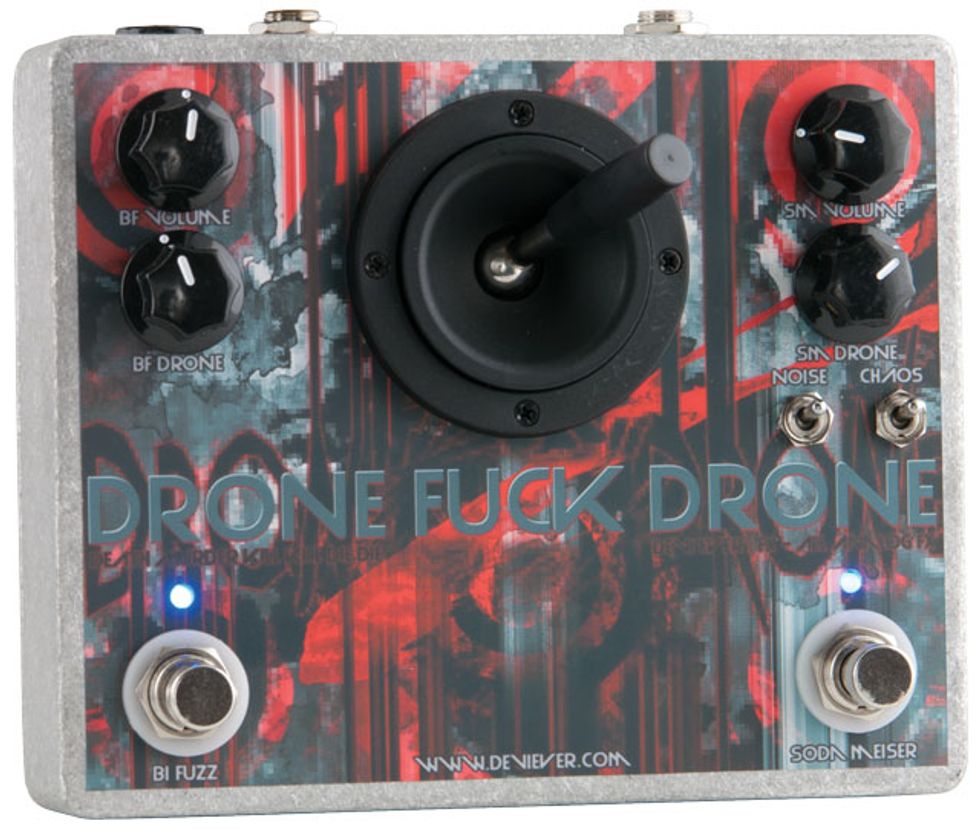In the decade since Devi Ever FX burst on the stompbox scene, the delightfully irreverent Portland, Oregon, builder has created a line of fuzz boxes that should make gearheads weep with joy. Used by the likes of Trent Reznor, Depeche Mode, ZZ Top, Wilco, and My Bloody Valentine, her pedals suit just about taste in the distortion/crunch/fuzz realm.
Devi’s pedals sound great, and her creative streak yields many unusual tones and control sets. The all-analog Drone F*** Drone, for instance, is the fifth Devi Ever pedal to employ a joystick. (The actual product name doesn’t include the word “F***,” but we’re pretty sure you can figure that one out.) The control lends an extra dose of expressive potential to a circuit that combines two of Devi’s most heralded fuzzes, the Bi-Fuzz and the Soda Meiser/Noise Floor. Together they generate an absolute maelstrom of noise, and for good measure there are a couple of extra switches that may leave you wondering whether you’ve blown up your amp, the pedal, or your town’s entire power grid.
The Fuzz Pilot
Throw a joystick on a guitar pedal and everyone will notice. You’d be forgiven for mistaking the DFD for an RC helicopter remote. Each of the two footswitches activates one of the fuzz circuits, with the status indicated by a tiny blue LED. The Bi-Fuzz on the left has only two knobs: volume and BF drone. Turning the drone knob fully counter-clockwise generates a steady fuzz tone. As you roll deeper into drone territory, the output becomes increasingly laced with white noise, descending into a hot mess of atonal delight. You can use the joystick to pinpoint various frequencies throughout its 360-degree range.
The adjacent Soda Meiser fuzz has similar controls and shares the joystick functionality. Higher SM drone settings produce modulation akin to R2D2’s whistle. Here the joystick alters both the frequency and the modulation rate. Fully counter-clockwise, SM drone produce the slowest wave. Rolling it down increases the speed until it decays into swarming fuzz. There are two additional switches under on the Soda Meiser channel: noise and chaos. At tame SM drone settings, chaos adds a layer of broken glass harmonics and upper-octave hair. Turning on the noise switch (with chaos off) transforms the siren tremolo into an air raid klaxon.
The design and build quality are excellent. There’s nothing special about the unfinished Hammond box, although the top decal—littered with .jpeg artifacts and oozing heinous fluorescents—certainly makes a statement. A peek inside revealed focused wiring, ultra-secure suspended PCBs, and a Garbage Pail Kids trading card thrown in for good measure. I was lucky enough to score Pasty Pierce.
Ratings
Pros: Two very heavy fuzzes plus drones. Joystick adds an extra cool functionality.
pros
Cons: Steep learning curve. Recreating specific drone sounds can be a little difficult.
cons
Tones:
Ease of Use:
Build:
Value:
Street:
$300
Devi Ever FX
deviever.com
You’re Deaf and Your Mind is Melting
At its simplest level, the Drone F*** Drone houses two very cool fuzzes. The Bi-Fuzz has lot of breathing room and is nearly silent when BF drone is turned down. Playing a Stratocaster and a Twin Reverb with the joystick around 9 o’clock, I captured the sharp, nasally yowl of a Tone Bender. Banking hard right on the stick cloaks the fuzz in a darker tone, like something you’d hear from Warren Ellis on a Grinderman record. Chords lurch, crumble, and then morph into one big note.
The Soda Meiser nails that doomy, Smashing Pumpkins-like sound of an op amp Big Muff. Coupled with an Orange OR50, this huge sound feels like ten layered Big Muffs, especially when using single-coils. Double bends feel like they’re ripping at the fabric of time. Kicking up the SM drone just a hair introduces the death rattle of a dying battery. Flipping on the chaos switch with a less intense SM drone setting coaxes a bristling attack that made me think of the opening of Boris’s Pink album. A Les Paul with humbuckers compresses some of this hairiness—not bad thing for “civilized” solos, but a little less fun.
You can also cascade the two fuzzes, producing the audio equivalent of a scrambled cable signal. (This cascading sounds better if you increase one fuzz’s volume to compensate for the colliding, canceling frequencies of this fuzz soup.) Another option: Run one drone while using the other as a more conventional fuzz voice. This can create mammoth walls of sound, though it can get disorderly, depending on how high you mix the drone.
Experimentally minded players will love how the Drone F*** Drone transforms their guitars into tone generators or demented synthesizers. I found some really dirty 8-bit tones with SM drone at 2 o’clock and both switches engaged. Introducing a Boss Loop Station opened the gate to endless tweaking. Thumping, brutish power chords provided a percussive foundation over which I could twirl the frequency stick and drop in input from the chaos switch, creating industrial chatter. Maxing both drones obliterates your input signal, generating a nightmarish wash.
The Verdict Buying a Bi-Fuzz and a Soda Meiser would set you back about $250. The Drone F*** Drone fetches $300—a substantial price, but oh-so worth it if you want to take fuzz way out of the box. Controlling the joystick with a foot in a live situation could get dicey, though the hardware is sturdy enough. There’s no end to potential studio applications—not just for guitar, but also keys, bass, and just plain noise. Adventurous players willing invest the time to explore the Drone F*** Drone will be repaid in spades.








![Rig Rundown: Russian Circles’ Mike Sullivan [2025]](https://www.premierguitar.com/media-library/youtube.jpg?id=62303631&width=1245&height=700&quality=70&coordinates=0%2C0%2C0%2C0)

















